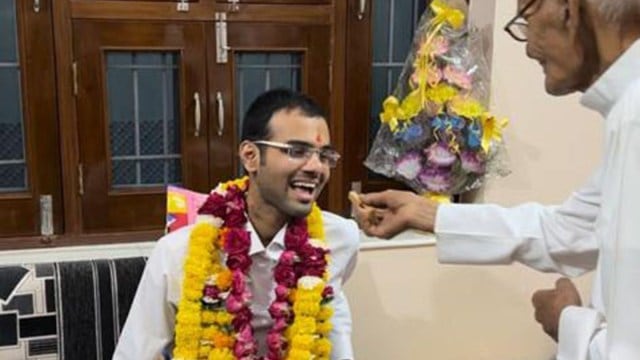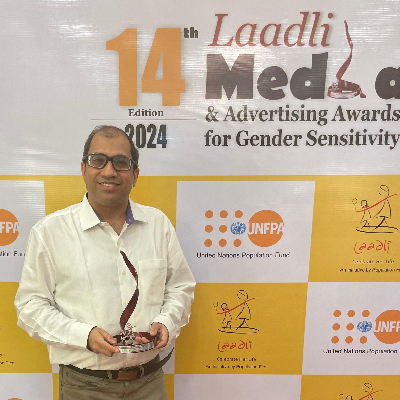
It was during his 21-day climb to be atop the 8,091-metre Mt Annapurna, 10th highest mountain in the world, that the 34-year-old from Kishangarh, Rajasthan, chose the wrong rope — a decision that saw him slip disastrously.
Story continues below this ad
On October 31, after nearly 200 days of hospitalisation in two countries, Maloo was discharged from AIIMS, New Delhi. After his rescue in April, doctors at Manipal hospital in Pokhara spent four hours trying to revive him. He was later airlifted to Mediciti Hospital in Kathmandu and subsequently to Delhi, where he was treated for organ damage —heart, kidney and lungs. The climber, who started walking just a few days back after physiotherapy, had to undergo plastic surgery to heal the frostbite in his right arm and torso.
 Mountaineer Anurag Maloo celebrating his birthday with his family members in the hospital. (Photo: Instagram/@anuragmaloo)
Mountaineer Anurag Maloo celebrating his birthday with his family members in the hospital. (Photo: Instagram/@anuragmaloo)
Received at home by family and friends, with smiles, tears of joy and marigold garlands; Maloo shares what he has learnt from the trauma: “Living every moment”.
Speaking to The Indian Express from Kishangarh he says, “Life is beautiful. That’s one thing you realise after being in hospital for so long that you better start living every moment you have. It feels really great that I am at home after more than seven months.”
He gets philosophical when talking about the long lonely days in the dark hole. “I was like a child in my mother’s womb after the fall. Mt Annapurna, the mother goddess, saved me and that’s why I am here, back home.”
Story continues below this ad
Maloo doesn’t remember much from the days after his rescue. “I don’t have any memories of the crevasse as well as my day at the hospital in Pokhara, where doctors gave me CPR for 4 hours before shifting me to Kathmandu. I can’t remember anything from the 10-12 days at Kathmandu before I regained consciousness and saw myself in wound dressings over my torso and right hand,” he says, as he thanks Dr Maneesh Singhal, Dr Suvashis Dash, the nursing staff, his parents, brother Ashish and sister-in-law Shikha for caring and praying for him.
 Maloo with the team from AIIMS Trauma Center and the Burns and Plastic Surgery ICU. (Photo: Instagram/@anuragmaloo)
Maloo with the team from AIIMS Trauma Center and the Burns and Plastic Surgery ICU. (Photo: Instagram/@anuragmaloo)
Maloo was treated at the AIIMS Trauma Center and also the Burns and Plastic Surgery ICU.
Not unnerved by his near-death experience, Maloo, like a true mountaineer, has already started thinking of planting his ice-axe on top of Mt Annapurna. “I have always believed that Mt Annapurna is the toughest mountain to climb and if I am going to attempt 8,000 metres, it will be Mt Annapurna. I somehow connect it with being the mother mountain and if I can climb Mt Annapurna, I can climb any other mountain in the world,” says Maloo, who works with Seedstars, a Swiss company, as an international development consultant.
From sharing his future climbing plans, Maloo seamlessly switches to the day when he made a costly wrong choice. Following an abandoned attempt to reach the summit, it was during the descent from Camp 3 to Camp 2 that Maloo fell in a deep ice crevasse on April 17.
Story continues below this ad
 Maloo had to undergo plastic surgery for the frostbite on his right arm. (Photo: Instagram/@anuragmaloo)
Maloo had to undergo plastic surgery for the frostbite on his right arm. (Photo: Instagram/@anuragmaloo)
“I took the wrong rope. My sherpa was behind me and I did not know which rope to take. If my sherpa was ahead of me, he would have known which rope to take. I have learnt my lesson,” he says.
The mention of his rescuers, the two Polish climbers, makes Maloo really emotional. Adam and Mariusz followed the unwritten bro-code of mountaineers — to use their skill set to help others. “I really get goosebumps when I see Adam’s rescue video. They were planning to bring my body out when Adam saw me and put his torch on my face. He saw my eyes blinking and faint breathing, so he noticed that I was alive. To rescue me in that deep crevasse with the pulley system was something only he could do at that time,” says Maloo.
He also shares the chat he had with Adam after his recovery. “I thanked him for everything he did to save my life. What more can I tell the man who saved my life? I am here because of all the risks taken by the team and Adam and the others to rescue me. It won’t happen to everyone. Life is short and small, and (it’s) better (that) you live it each day. That’s how I would like the world to see my story. And hopefully I will recover and start mountaineering again,” he says.


 Mountaineer Anurag Maloo celebrating his birthday with his family members in the hospital. (Photo: Instagram/@anuragmaloo)
Mountaineer Anurag Maloo celebrating his birthday with his family members in the hospital. (Photo: Instagram/@anuragmaloo) Maloo with the team from AIIMS Trauma Center and the Burns and Plastic Surgery ICU. (Photo: Instagram/@anuragmaloo)
Maloo with the team from AIIMS Trauma Center and the Burns and Plastic Surgery ICU. (Photo: Instagram/@anuragmaloo) Maloo had to undergo plastic surgery for the frostbite on his right arm. (Photo: Instagram/@anuragmaloo)
Maloo had to undergo plastic surgery for the frostbite on his right arm. (Photo: Instagram/@anuragmaloo)





























